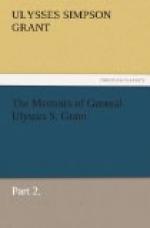There was a considerable force of State militia at Camp Jackson, on the outskirts of St. Louis, at the time. There is but little doubt that it was the design of Governor Claiborn Jackson to have these troops ready to seize the United States arsenal and the city of St. Louis. Why they did not do so I do not know. There was but a small garrison, two companies I think, under Captain N. Lyon at the arsenal, and but for the timely services of the Hon. F. P. Blair, I have little doubt that St. Louis would have gone into rebel hands, and with it the arsenal with all its arms and ammunition.
Blair was a leader among the Union men of St. Louis in 1861. There was no State government in Missouri at the time that would sanction the raising of troops or commissioned officers to protect United States property, but Blair had probably procured some form of authority from the President to raise troops in Missouri and to muster them into the service of the United States. At all events, he did raise a regiment and took command himself as Colonel. With this force he reported to Captain Lyon and placed himself and regiment under his orders. It was whispered that Lyon thus reinforced intended to break up Camp Jackson and capture the militia. I went down to the arsenal in the morning to see the troops start out. I had known Lyon for two years at West Point and in the old army afterwards. Blair I knew very well by sight. I had heard him speak in the canvass of 1858, possibly several times, but I had never spoken to him. As the troops marched out of the enclosure around the arsenal, Blair was on his horse outside forming them into line preparatory to their march. I introduced myself to him and had a few moments’ conversation and expressed my sympathy with his purpose. This was my first personal acquaintance with the Honorable—afterwards Major-General F. P. Blair. Camp Jackson surrendered without a fight and the garrison was marched down to the arsenal as prisoners of war.
Up to this time the enemies of the government in St. Louis had been bold and defiant, while Union men were quiet but determined. The enemies had their head-quarters in a central and public position on Pine Street, near Fifth—from which the rebel flag was flaunted boldly. The Union men had a place of meeting somewhere in the city, I did not know where, and I doubt whether they dared to enrage the enemies of the government by placing the national flag outside their head-quarters. As soon as the news of the capture of Camp Jackson reached the city the condition of affairs was changed. Union men became rampant, aggressive, and, if you will, intolerant. They proclaimed their sentiments boldly, and were impatient at anything like disrespect for the Union. The secessionists became quiet but were filled with suppressed rage. They had been playing the bully. The Union men ordered the rebel flag taken down from the building on Pine Street. The command was given in tones of authority and it was taken down, never to be raised again in St. Louis.




